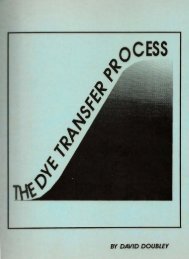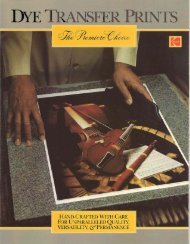Pan Matrix Film Processing - David Doubley
Pan Matrix Film Processing - David Doubley
Pan Matrix Film Processing - David Doubley
Create successful ePaper yourself
Turn your PDF publications into a flip-book with our unique Google optimized e-Paper software.
analyzer for making prints for similar negatives.<br />
For future reference use the analyzer find corresponding exposure series of flesh tone, greens, blue sky, etc., for use<br />
when determining color and exposure of other color negatives.<br />
5.2.7 Masking Color Negatives. One commonly occurring problem is too much color contrast in a color<br />
negative. Usually, this is caused by excessive subject contrast. One way to reduce excessive contrast is to make a<br />
contrast reduction mask. The mask is made in much the same way color masks are made when making separation<br />
negatives from color transparency film. The contrast reduction mask is registered with the color negative when making<br />
the <strong>Pan</strong> <strong>Matrix</strong> <strong>Film</strong> 4149 exposures.<br />
The mask is made on 4x5 Kodak <strong>Pan</strong> Masking <strong>Film</strong> 4570. In addition to this, you will need a diffusion sheet to<br />
diffuse the image and two pieces of 4x5 plate glass, one piece to keep the film flat during exposure, the other to<br />
separate the masking film from the color negative. If you are using 35mm or 2-1/4" film then you will not need the<br />
separating glass. For larger films up to and including 5x7 use 1/8" glass and for even larger films use 1/4" glass.<br />
The mask can be taped to the original color negative or a registration carrier can be used. Because there should be<br />
fairly good contact between the negative and the mask, some sort of glass carrier should be used. If you prefer to use a<br />
registration setup see section 4.2 for information on how to prepare the color negative.<br />
Set the enlarger lens aperture to its widest opening, then raise or lower the enlarger head until the illumination is<br />
about 3 footcandles. You can obtain 3 footcandles by using a light meter or built-in camera meter. Set the light meter<br />
for an ASA (ISO) of 400, a shutter speed of 1/8 second, and aperture setting of f/5.6. Take a reflecting reading off a<br />
white card at the easel height, raise or lower the enlarger head until the illumination matches the light meter's settings.<br />
Once the illumination is set, close down the aperture by 3 stops.<br />
Lay a piece of black paper on the easel to reduce any reflections. In the dark, lay the <strong>Pan</strong> Masking film (with the<br />
emulsion up) on the easel, then lay the separating glass on top of it (for large size film only), next place the diffusion<br />
sheet on top (with the textured side up), the color negative lays on top of the diffusion sheet with the emulsion down,<br />
and finally place a clean piece of glass on top of this. The exposure will be made through this assemblage. This can be<br />
seen more clearly in Figure 5.2.1.<br />
Before making the exposure, add blue filters to the light beam to overcome the reddish color of the negative. Use<br />
four 50CC blue filters or a 47B filter. A tentative exposure time will be about 10 seconds. This of course is dependent<br />
upon the color negative's overall density. I suggest you make a test strip. The ideal exposure will have barely<br />
perceptible detail in the highlight. Avoid over exposure.<br />
After the exposure, develop the mask for 3 minutes in HC-110 dilution F (1:19) or DK-50 (1:4) at 68 degrees<br />
Fahrenheit. The film should receive continuous agitation in a tray.<br />
The mask should be in register on the base side of the negative and the color negative should be placed<br />
EMULSION DOWN in the carrier. The matrix film exposures times will be about 1-1/2 times longer than that for an<br />
unmasked color negative. The overall effect is to lower the contrast of the final dye print.




